Tom Bender
tbender@nehalemtel.net tombender.org
Life-force energy (qi, chi, prana, baraka, etc.), is a foreign concept to many in our culture, though core to the healing and martial arts, philosophy, architecture, and access to the sacred, of more than 65 cultures worldwide.1 Such “foreignness” of other cultures is often a valuable reflection of blindness in our own, and therefore worth exploring. A good example is our scientists refusing to acknowledge the logical implications of quantum connectedness. If every element of our universe is quantum connected to all others, there is total informational interconnection, and therefore an “integral consciousness” existing in every grain of sand. Though acknowledged by most other cultures, this is a profoundly different universe than our culture thought we inhabited!
The architectural history of those cultures, plus current design projects, demonstrate the central role which life-force energy plays in the nurturing power of place, architecture, and community. Its acknowledgement and use offers a significant contribution to our capabilities as architects.
Life-force energy is the innate core dimension energizing otherwise ordinary things, nature, and the everyday, evoking special meaning for individuals, societies, and cultures. We are finally beginning to develop tools and processes to explore, verify, and work with this energy.
1 In the limited space here, I can only give a glimpse of the topic, but with hotlinks to more detailed information on various aspects. The 65 cultures worldwide whose core is life-force energy are listed on my website, and in my BUILDING WITH THE BREATH OF LIFE, and SILENCE, SONG, AND SHADOWS.
BUILDING WITH THE BREATH OF LIFE, 2000, is a left-brain introduction to historical and current use of life-force energy in design of sacred places, with over 300 images, two hundred plus references and a similar number of citations from published work by others in various related fields. It also provides exercises for those wanting to experience this field and develop their own skills in it. Draft chapters without images are available on my website.
SILENCE, SONG, AND SHADOWS, 2000, is a right-brain introduction to the same topic, focusing on emotional and color image introduction to the core concepts and elements.
The ENERGETICS INDEX and ARCHITECTURE AND THE SACRED INDEX on my website hyperlink to numerous sources of my own work specific to this topic – books, dvds, articles, chapters, presentations, monographs, calendars, built projects, etc. – and their support references.
“Sacred Art, Sacred Space”, 2006, demonstrates the different roles of art and architecture in a world where all is held sacred, and where the primacy of energetic realms is understood.
My “Living Architecture” chapter from Kellert, Heerwagen and Mador’s BIOPHILLIC DESIGN, 2008, provides several dozen reference sources relative to architecture, life-force energy, and the sacred.
“Places Touching Spirit”, 2006, shows how our places can bring us into deeper connection with the rest of creation.
Our acknowledgement of life-force energy is deeply connected with a major shift in understanding of the physics of our universe. The Hubble telescope, and now other equipment, is transforming our culture’s concepts of astro-physics, showing that our universe is formed from electromagnetic plasmas, not inert matter.[1] Those plasmas appear to originate in a “mirror realm” to our 3-D world, which is the realm of life-force energy, and where actions actually occur that we attribute to our 3-D world. Parallel with this new perspective, information is coming together about the physics of qi energy and its implications for culture and architecture.[2]
Exploring the architectural history of other cultures is showing us the nature and power of lifeforce energy-sourced design and experience of place. The tools employed in those cultures, and the roles that their built environment plays are first steps in developing our own. Those working today with these tools are developing new techniques for working with life-force energy to imbue our architecture and surroundings with the healing and nurturing power inherent in this energy.
Many different cultures express the core role of life-force energy in our surroundings, everyday life, and energizing the places we create and inhabit:
THE POWER OF NATURAL PLACES:
Suzanne Wenger speaks of the life-force energy power of undamaged natural places in Nigeria and elsewhere:
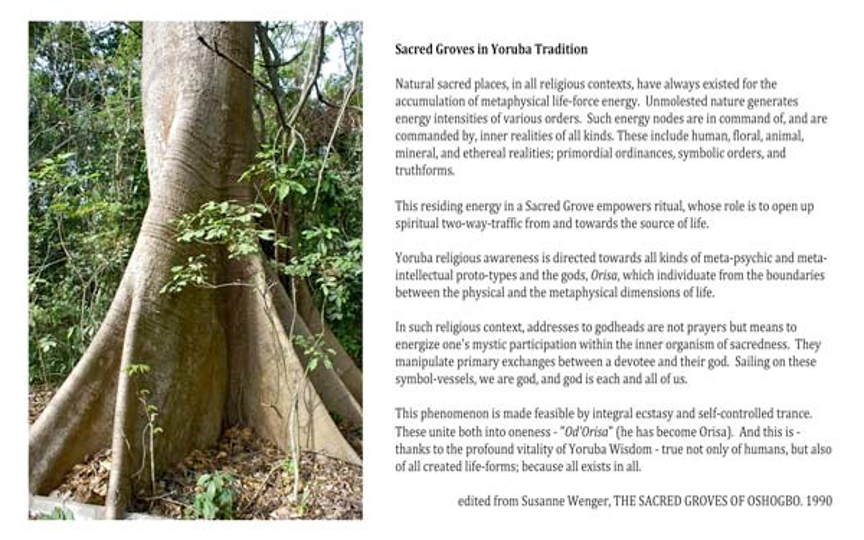
EVERYDAY SACRED SITES IN PUEBLO VILLAGES:
Joseph Rael speaks of everyday living with life-force energy in Native American Pueblos:
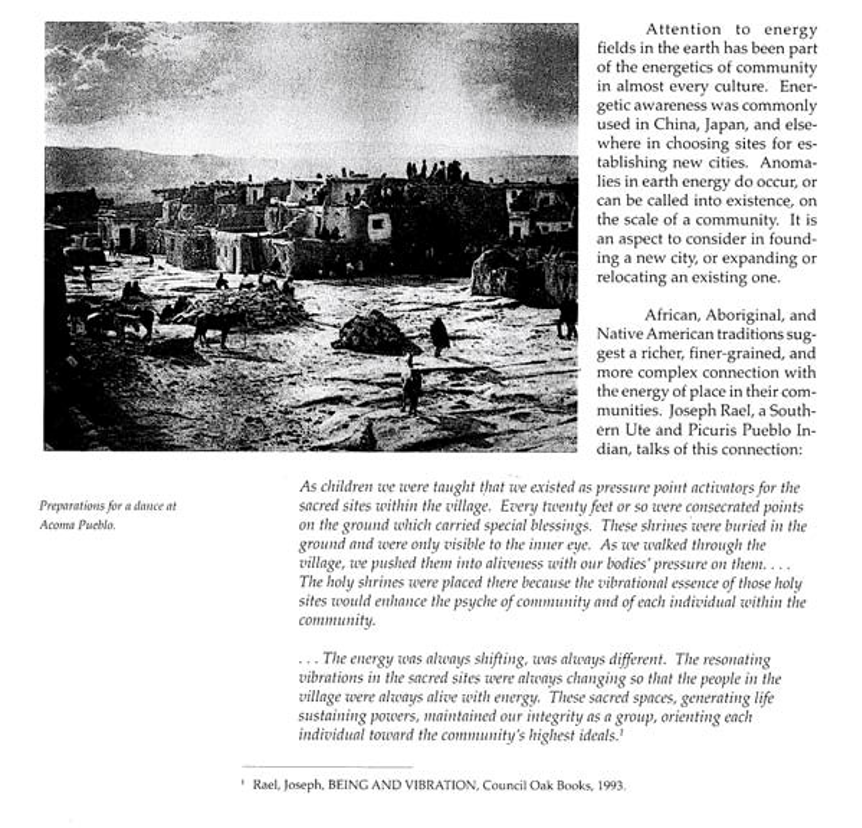
EARTH ENERGIES:
One of many aspects of life-force energies in the places we inhabit is “earth energy” – distinct concentrations of qi-energy in various natural places, often caused by discontinuities in the earth’s crust. Machu Picchu, for example, is located on a huge batholith of crystalline granite, with a geologic fault-line on each side of it. Compression of the granite along those faults generates piezo-electric currents, which accumulate in the granite shards that underlie the site, giving the site unique power to connect with the spirit realms. Other well-known sites such as Serpent Mound, the cenotes in the Yucatan (below), or the Kiyomizu Shrine in Japan are such naturally energy-distinctive places. Such energy can also be brought into a place by a variety of means, accumulate in a place through its use or design, or be altered though shamanic action.
THE CENOTES OF YUCATAN:

CHINESE CITY DESIGN:
68 BUILDING WITH THE BREATH OF LIFE
| Above: Chang’an of the Tang The Emperor was placed in the north of this rectangle, as he always faced | |
| Dynasty – axial and rectangular layout typical of Chinese administrative cities. Symetrical layout of markets, axial location of the Imperial quarter on the north, facing south, grid street layout; walled, enclosed blocks. Below: The Western Gate of Beijing in the 19th century – an impressive greeting for visitors. | the holy south—in alignment to receive the growth-granting forces of the earth and sun. In the northeast, temples were built to a guardian deity, as that direction was felt to be unlucky; devils dwell in the mountains (as well as enemy troops). Buddhist temples were often placed in the west, as it was felt that Buddhism had a tendency to proceed eastward, and their influence would positively affect the city. The entire geometry and detailed layout of the city symbolically reflected and reinforced their understanding of the cosmos. Thus sites were selected with mountains to protect the city from winter winds, and monasteries were founded in the mountains so that the city could be warned of attack. Southern orientation brought sunlight, warmth, cheer, and sanitation. Fresh water and air were provided for by proximity of the mountains and rivers, and the commerce and food supply of the city assured by the proximity of a river to the east and fields to the south. At the same time, every activity involved in making the city, living in it, and participating in its life reminded a person of the forces that acted upon their world. They became aligned with those forces, and gained nourishment from them. |

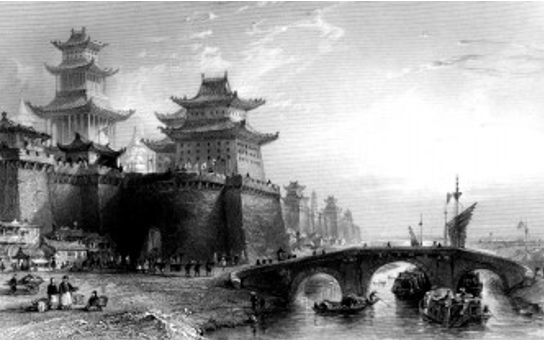
FENG-SHUI OF CHINESE CITIES: MIRRORS OF THE COSMOS
Feng-shui outlined a process for locating and laying out Chinese cities. The view of the cosmos on which city location was based spoke symbolically of four Gods: one dwelling in a stream to the east, one in a plain to the south, one in a highway to the west, and the fourth in a mountain to the north. A site with these surroundings was felt to be suitable.
A rectangular plan was made in the symbol of the cosmos, reflecting the rhythms of the sun, the stars, and the seasons that most strongly affected the land. The east-west axis is the path of the sun and the stars. The north-south axis is the direction of the still point in the heavens and the yearly path of the sun and the moon through the seasons.
This Chinese tradition of clearly placing themselves and their places of living within a pattern of the forces of the universe played out in a similar configuration of the Ming Tang, or “Bright Hall.” In this ritual temple, the Emperor followed a progression of ceremony within the circle of the seasons, with the configuration of the temple complex tied to the same heavenly directions. Similar patterns determined the design of tombs, possibly including that of Qin Shihuang.
JAPANESE “KAMI”, OR EARTH SPIRITS:
Another interesting example involves a dowsing study we did in 1998 confirming existence of the Kami, earth-energy “spirits” in Japan, their annual “retreat” at the Izumo Shinto Shrine, and the ability of dowsing to track such events from around the world:
58 BUILDING WITH THE BREATH OF LIFE
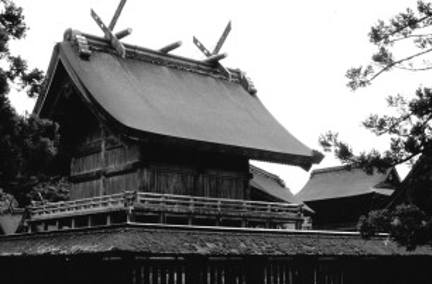
Right: Honden, or main shrine building at Izumo Taisha, in ancient Shinto style.
VISITS OF THE KAMI
TO THE
IZUMO SHRINE, JAPAN
Located near a small bay on the west side of Honshu Island across from Hiroshima is the Izumo Shrine,
the most ancient Shinto shrine in Japan. This shrine has been venerated continually for well over a thousand years. Every year in late fall the kami, or earth spirits, of Japan leave their normal homes throughout the country and gather for a week at the shrine. During this period, the Shrine is also visited by thousands of pilgrims who have come to celebrate the arrival of the kami. This visit of the spirits even has a special name in the Japanese language – the period of the visit is known as kami-arizuke (period with the gods) at Izumo, and kannazuki (period without gods) in all other parts of Japan.
At the time of their 1998 visit, we performed an experiment in remote dowsing to see if the visit caused any change in the chi energy of the Shrine’s site. Dowsers Sig Lonegrin in Europe; Joey Korn and James Sullivan in North America; and Hitomi Horiuchi in eastern Japan dowsed a map of the shrine precincts before, during, and after the visit of the kami.
Below: Diagrams by dowser Joey Korn showing multiple crossings of energy lines on main shrine buildings while kami were in residence.
All found a major change in the energy of the site during the visit, and a return to the earlier energy state after the departure of the spirits. One dowser registered confusion because his reading first showed an energy node at one shrine building, and rechecking later, found it at a different building. A call to the Shrine produced a schedule of events during the week, which indicated that a welcoming ceremony had been held at the first building at the time of the first reading; and later the spirits moved to the second building for another ceremony!
In spite of the Westernization of Japan, the Japanese still acknowledge the existence of the kami and continue their annual visits to the Shrine to honor them, as they have for probably more than a thousand years. The presence of the spirits is still perceptible to visitors, and people gather from around the world to celebrate and honor them.
Light lines are “echos” of opposite energy resulting from the abrupt shift in energy. Right: Energy lines on site before and after kami visit.
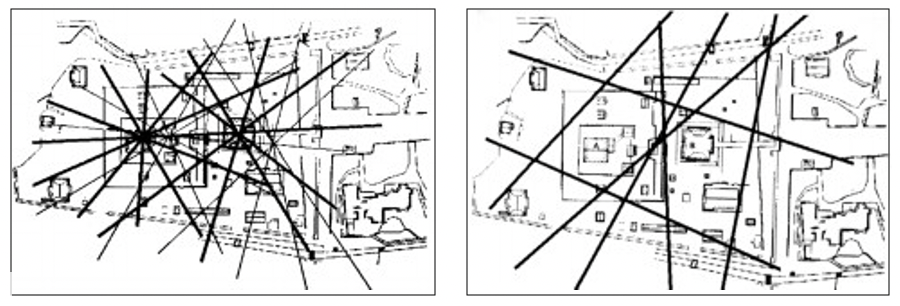
TOOLS FOR WORKING WITH LIFE-FORCE ENERGY IN DESIGN:
The tools used by “architects” in various cultures to work with life-force energy in design are amazingly varied and powerful:
- The use of geometry in the faceted vaulting of Islamic mosques, in Hindu temples, or tantric sculpture in the Ellora Cave Temples in India[3].
- Location of “birthing stones” in Hawaii to give power to women giving birth.
- Determining the location of Japanese temples by dowsing, to find powerful existing earthenergy locations.
- Empowering of images and structures by “Opening of the Eyes” process in Egyptian, Buddhist, Native American locations.
- The use of non-rectangular detailing in the architecture of the Rudolf Steiner tradition.
- The role of ritual in design, construction, use, and decommissioning of energized places.
- Moving life-force energy throughout the Khmer lands in Cambodia through water temples and irrigation canals.
- Design and empowering of Chinese cities and tombs.
- Use of feng-shui, vaastu, and other related processes in designing homes, temples, communities in different cultures.
- Rebuilding of Mayan temples as the astrology and rulers changed.
- Incorporation of materials from previous temples in construction of new temples in Egypt.
- Design of temples in Egypt to incorporate and link to the energy of other deities and previous temples.
- Creating energized “Gardens of the Spirit”.
- Design and energizing tombs, temples and statues to connect the living with deceased pharaohs, rulers, or spiritual leaders.
- Use of energized walls or boundaries to protect and empower spiritual precincts.
The presentation at Ghost Ranch will focus on imagery of the above historical architectural elements and on current projects working with life-force energy.
CONCLUSION:
Our architecture and culture have been missing a vital dimension that energizes place, lives and culture. Our practice of architecture is being deeply transformed and empowered as our culture, life experiences, and professional work embrace and work with life-force energy.
[1] For a summary, see “Plasma Universe” on my website, or visit Thunderbolts.info.
[2] See “Physics of Qi” on my website, or for more detail, view my PHYSICS OF QI DVD.
[3] See my THE CAVE TEMPLES OF INDIA DVD, 2004.



